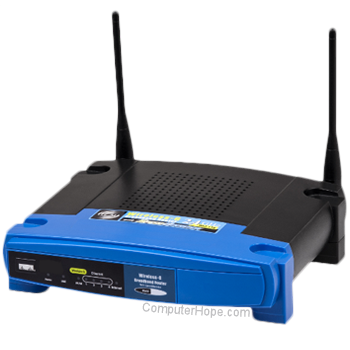Wireless

Alternatively called cordless, wireless describes technology that transmits information or electricity through the air electromagnetically, without wires. The wireless transmission medium may be light, sound, or a magnetic or electric field distortion.
A wireless communication may also be called unguided media.
Cordless hardware
Cordless computer hardware devices such as a cordless mouse or cordless keyboard can use Bluetooth, Infrared, or RF (radio frequency). However, today, it's often either Bluetooth or RF.
Although cordless devices require no wires, they require some device to broadcast a signal. For example, a Bluetooth mouse requires a USB (universal serial bus) Bluetooth transceiver to send and receive signals from the mouse. Also, all wireless hardware devices require batteries for power.
Wireless networks

Wireless networks, commonly known as Wi-Fi networks, utilize one of the IEEE 802.11 standards for wireless communication. Today, wireless routers that offer Wi-Fi have become common in most homes as a way for computers, smartphones, tablets, and other wireless devices to connect to the Internet.
Wireless broadband
Besides wireless networks in the home, there are other broadband wireless solutions, such as EV-DO (Evolution-Data Optimized), Satellite (e.g., Starlink), and WiMAX (Worldwide Interoperability for Microwave Access). Smartphone users can also use their smartphone as a wireless hotspot and connect to that hotspot with their computer.
Smartphones and cell phones

Today's smartphones and cell phones use many wireless technologies to communicate with cell towers, Wi-Fi, and other devices. Phone calls use a spectrum of radio waves that allow wireless communication between the phone and cell towers, which relay the signal to other towers or locations.
When communicating over the Internet and not using Wi-Fi, smartphones have many different technologies, including 2G, 3G, 4G, GPRS (General Packet Radio Service), GSM (Global System for Mobile communication), and LTE (Long-Term Evolution).
Finally, smartphones use Bluetooth when communicating with other devices (e.g., car, headset, or speakers).
Other examples of wireless devices

There are many wireless devices available today. To help prevent conflicts between wireless devices, each device category has a designated frequency area (spectrum).
- AirPods and other wireless earphones.
- AM / FM (frequency modulation) radio
- Apple AirPort
- Apple Pencil
- Baby monitors
- Broadcast TV
- Car key remote
- CB (citizens band) radio
- Cordless phones
- Garage door opener
- GPS (Global Positioning System)
- MySensors
- Remote control cars, airplanes, and other vehicles.
- Radar for air traffic control.
- Radar for weather
- Radar speed detector
- RFID (radio frequency identification)
- Satellite TV
- Security cameras
- Standard time broadcast
- Toll-road payment transponders.
- Two-way radios
- Walkie talkie
- Wireless doorbells
- Wireless fence
- Wireless headphones, microphones, speakers, and other audio devices.
- Wireless health monitors
- Zigbee
Can I have multiple wireless devices in my home?
Yes. You can have multiple wireless devices in your home. However, if any wireless device shares the same frequency range, you may run into problems if two or more devices use the same range at the same time. When problems occur, you may have a wireless device temporarily stop working.
Your neighbor's wireless devices can cause problems with wireless devices in your home.
For more sophisticated wireless devices like a wireless router, it's possible to switch the wireless frequency range to fix conflicts.
How does information travel wirelessly?
One way data is transmitted wirelessly is with FSK (frequency-shift keying), an FM (frequency modulation) scheme that manipulates the frequency of the carrier wave. For example, with BFSK (binary frequency-shift keying), the carrier wave is manipulated into two frequencies. One frequency represents a "0" (zero), and the other represents a "1," which is how to transmit binary, the primary language used for all computers and electronic devices. The receiving device can take the binary data and convert it into audio, video, or other data.
AirPlay, AM, Centrino, Chirp, Computer acronyms, Cord, FM, LPWAN, MIMO, Phone terms, PM, Satellite, Spread spectrum, Unguided media, WAP, Wi-Fi, Wired, Wireless charging
